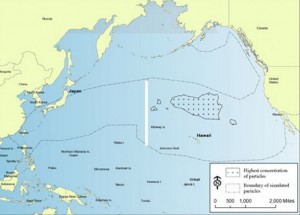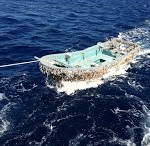NOAA: Japan Tsunami Debris Still Expected
Debris generated by the March 2011 tsunami in Japan will likely continue to reach the shores of Hawaii at least through the upcoming winter, according to a representative of the National Oceanic and Atmospheric Administration.
Carey Morishige, Pacific Islands Regional Coordinator for NOAA’s Marine Debris Program, gave a briefing Friday to county and state officials on the status of the federal government’s efforts to track the debris.
Morishige said so far only 15 items found along Pacific shores from Canada, to the US mainland, to Hawaii have been confirmed as debris from the tsunami generated by the 9.0-magnitude earthquake that killed nearly 16,000 people.

This NOAA image shows the estimated location of particles of debris from the Japan tsunami as of early September.
She said two of those items were encountered around Hawaii: a blue plastic storage bin found floating in the ocean off Oahu in September, and a 20-foot skiff found floating by a fishing vessel 700 nautical miles northeast of Maui in early October.
Also in September, a fishing boat from Maui encountered a floating dock north of that island that had Japanese writing on it. It was later sighted north of Molokai but then wasn’t seen again.
While the bigger items like docks – one 66 feet long and weighing 188 tons washed up on an Oregon beach in June – get the headlines, a large amount of smaller debris is believed to still be traveling around the Pacific.

A skiff found floating 700 nautical miles from Maui by the fishing vessel Zephyr. Photo courtesy of P. Grillo.
Morishige said items that are floating or only partially submerged – including at least one soccer ball – are susceptible to winds and move the fastest. Smaller items and particles in the water are pushed only by currents.
“The majority of the slow-moving stuff is still to come,” she said.
The Japanese government estimated that the tsunami generated 5 million tons of debris. However, roughly 70% of that was believed to sink near Japan’s coast.
“We don’t know how much of that still remains afloat,” she said.
Morishige said the debris plume at first could be observed using satellite imagery.
But within a month, the plume had dispersed to the point that it was no longer visible from satellites, so NOAA developed a computer model to attempt to track its progress.
“[The debris] is spread out across an immense portion of the North Pacific,” she said.
However, its location is largely unknown because the effect of the combination of wind and currents is extremely difficult to predict.
It will also be a challenge to distinguish the tsunami debris from everyday marine debris, some of which bears Japanese markings, Morishige said.
The occurrence of marine debris “did not start, and will not end, with the tsunami,” she said.
Like other types of marine debris, that generated by the tsunami can show up almost anywhere on the Big Island’s shores. However, most is expected to turn up at Kamilo Beach in Ka`u, where currents and their “wrap-around effect” have deposited hundreds of tons of marine debris in the past.
The Hawaii Wildlife Fund, the non-profit group which has organized most of the Kamilo Beach cleanups, has another one planned for the Ka`u coast on Saturday.
Participants will meet at Waiohinu Park at 7:45 a.m. Information is available at 769-7629 or by email at [email protected].
While the location of the tsunami debris remains mostly a mystery, Morishige said experts agree on one thing: it will be highly unlikely that it will have elevated levels of radioactivity.
That is because the debris has also been floating around the ocean for more than 18 months, and most of it was already offshore when problems developed at the Fukushima Dai-ichi nuclear plant.














